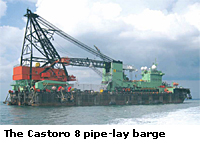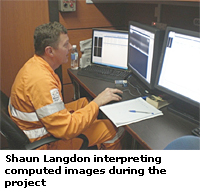First for Oceaneering Inspection
27/04/2009
 Oceaneering Inspection has completed what is believed to be the first ever offshore pipeline project to be inspected using computed radiography (CR) technology.
Oceaneering Inspection has completed what is believed to be the first ever offshore pipeline project to be inspected using computed radiography (CR) technology.The project, a joint venture (JV) between Oceaneering and Global TSG was completed offshore Northern Territories, Australia. Introducing a new era in radiography for pipelines, a great deal of interest has been shown within the inspection industry in the progress and successful completion of this pipeline. The 128 km 'Blacktip' pipeline project on board the Castoro 8 pipe-lay barge has proven that new technologies can provide safer and more environmentally friendly working conditions.
The 18-inch pipeline with a wall thickness of 15.1 mm was welded using the Paso welding system. The 3 degree bevel weld prep and a desire to reduce the inherent risks and production problems associated with radiation meant that computed radiography was the optimum inspection technique.
 The benefit to the client of being able to reduce the exposure time in comparison to conventional radiography was an important factor; a 100 s exposure becomes a 10 s exposure (D7 film v CR). Computed radiography requires less radiation to produce an image, therefore by reducing the radiation output and energy (kV), smaller controlled areas are required. The fact that CR requires no processing chemicals alleviates the risks and environmental harm associated with transportation, storage, spillage and disposal.
The benefit to the client of being able to reduce the exposure time in comparison to conventional radiography was an important factor; a 100 s exposure becomes a 10 s exposure (D7 film v CR). Computed radiography requires less radiation to produce an image, therefore by reducing the radiation output and energy (kV), smaller controlled areas are required. The fact that CR requires no processing chemicals alleviates the risks and environmental harm associated with transportation, storage, spillage and disposal. Computed radiography is certainly not new and has been used in the inspection industry for many years. However, the availability of image plates that are flexible and in sizes suitable for pipelines inspection has made computed radiography for pipelines a reality. Oceaneering has secured three further offshore pipeline projects starting in 2009 that will utilise computed radiography; the projects are in Australia, Middle East, and South East Asia.
www.oceaneering.com